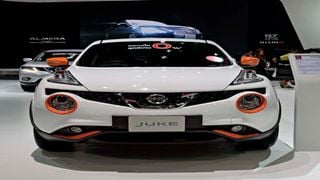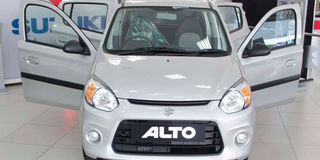
Nissan Juke
| ShutterstockDN2
Premium
True, the Nissan Juke is not a looker, but it’s a really good car
Hello Baraza,
I was just wondering if car manufactures know it when they are launching an ugly car. What do they think of the buying public? Do they expect the worst or do they still expect it to sell? Kindly review the Nissan Juke. I see people buying it despite the car being one of the ugliest in the market. I think it draws its inspiration from amphibians, particularly bull frogs. Why would one spend their hard-earned money on this car?
Donald (Trump)
Hello Donald Trump,
Car manufacturers sometimes do strange and incomprehensible things, such as launching a vehicle that obviously offends. Sometimes the ugliness is deliberate, to make a vehicle stand out in a crowded segment, but sometimes the aesthetic offense is the result of a porous approval system that allows gross design misconduct to seep through the cracks and find its way to a showroom within your sightline.
Well, sometimes despite the visual horrors fostered upon us, these vehicles find buyers, in huge droves. Again, the Nissan Juke falls squarely in this category: they have sold several boatloads of them and they seem to be gaining a cult following in the country, especially among the ladies, which just goes to prove that we can never really understand women since we assume they like pretty things. However, there is more to the Juke besides the undiluted ugliness: it is actually a really good car. Very good to drive, compact enough to manoeuvre like a hatchback but the design language in which the wheels are pushed to the far corners of the body means that interior space is at a premium.
I have driven a standard Juke, and I found it to be good. This was in 2013, in California, where I was allowed to drive around Los Angeles in it by myself as I tried to find the Hollywood sign.
I also drove something called a Juke RS which had performance enhancements, red stitching on the seats, steering and dashboard, and I found it to be better than the standard one: much better. This is the point at which the aesthetics stop being a factor and you love a car for the smiles it puts on your face. Buy a Juke RS if you can.
Or go for the Juke R, the one car that has come closest to making me soil my pants. You see, the first time I drove an R35 Nissan GTR was in 2013 when they launched the 550hp upgrade, and I did a breathless review of the experience in this column. The Juke R is a Nissan Juke... with GTR running gear. The body is beguiling Juke habiliments, but underneath the skin is the 3.8-liter twin turbo V6 with a torque vectoring AWD system and driving the Juke R made me change some perspectives about what a car can do and what a car should do.
Granted I didn't hammer it as hard as I did the actual GTR, but I was on a steep learning curve, and sitting a wee bit off the ground as you tackle a military airfield at speeds on the ambitious side of 200km/h can start to get hairy when the self-preservation instinct is waging a relentless war against the ego. It is one of the most memorable events in my entire career.
This will sound strange coming from me, but the Nissan Juke is not half bad, once you look past the froggy countenance.
****

A Suzuki Alto.
C’mon, are you sure you want any of these?
Dear Baraza,
Which one would you choose between the Daihatsu Mira, Mazda Carol and Suzuki Alto? Also, which one would you recommend for taxi? What about personal town driving?
Don, Nairobi.
Hi Don,
To be honest, I wouldn't choose any of these cars, they're punier than my chances of winning a jackpot under these proliferating betting franchises, not for taxi work and definitely not for personal town driving. Allow me to divulge the ruminations of an old man on this subject:
Taxi work is a paid service, and as such, there are expectations from the client. One of these expectations is comfort, and cars the size of fax machines do not exactly excel in this regard. I am not asking you or any other cab service provider to invest in a Mercedes, this is Nairobi, not Berlin - but if you want to do taxi work, I'm not sure forced intimacy between you and your client is going to be a plus. This only applies to some other type of service provision whose legal and moral implication is a matter that is open to interpretation.
However, we have had an influx of ride hailing companies whose stipulations demand the use of a small vehicle to ensure profit when these stipulations come head to head against seed money and revenue streams, after all, you are in it to make money, not fulfil bucket list ambitions such as riding back left in a German saloon.

A Mazda Carol
Personal and societal standards are a moving target, which is why these ride hailing companies can get away with using tiny hatchbacks as pay-for-transport modules.
In Kenya, we'd use the ride hailing app to summon a taxi, then a Suzuki Alto shows up, and we'll board that Alto without qualm even though you can see the inside of the driver's ear from the back seat where you are trying to avoid his endless chatter about politics or football or both. In other societies, the Alto wouldn't even be approved for sale, let alone for use as a taxi cab. That means that around here, any of these three cars you list would work just fine as a taxi.
Town driving? It involves wrestling against egomaniacs in giant SUVs, psychopaths helming overage PSVs and untrained bo'suns struggling to corral barely functioning vegetable trucks. Are you sure you want to do battle against this lot when your only weapon is a sub-1.0 litre tumbledown the size of a municipal dustbin? I have two fairly large German saloons and I dare not get into this skirmish, visiting town for me involves boarding a matatu, so let that driver compete against his fellow psychopaths, not me.
I know this flies in the face of sentiments I have expressed before, sentiments along the lines of these vehicles being ideal for inner city application due to their tractability occasioned by their small footprints — and that is true, empirically — but when you look at the bigger picture, intra-urban personalised transport is living on borrowed time.
In an ideal metropolis, travel into and out of the city should be by high capacity public transport, and that is why the BRT is coming. A wealthy society is not one where the poor drive cars, but one where the rich use public transport.
That said, you asked a question, and the answer was "none", but you clearly expect a more useful response so here it is.
The Mazda Carol and the Suzuki Alto are the exact same car, from the mechanicals to the bodywork, so splitting the two boils down to which nameplate tickles your fancy. They're both fairly unattractive 660cc cars that can be had with a manual or a CVT, which doesn't sound like much, but then again you could pony up for a Turbo RS edition that should spice things up a little and prevent you from nodding off while driving.
The Daihatsu Mira is none of this. It looks better, though it's not exactly the last word in automotive design, and it's slightly larger. It too is available as a 660cc but there is also a 996cc Toyota 1KR-FE engine available, the same engine you find in Passos, Beltas and Vitzes.
I have used this 1KR engine and it isn't as milquetoast as the paucity of cubic inches would suggest. The Mira has a choice of three transmission types: manual, auto and CVT, over the other pair's choice of only two. If you are after some excitement, there is the TR-XX version which is the cooking model, and I remember back in the mid-90s as I was honing my petrolheadedness, I came across an early precursor of this model which had one of the longest names in the industry: the Daihatsu Mira Cuore Avanzato TR-XX. I don't know why a car needs so many labels, but it was tall and red and narrow like a telephone booth and its review was one of the most hilarious reads I have ever come across. Of course that makes it the winner here: not the wider choice of engines and transmissions, not the larger size, not the better looks, but the numerous names of its ancestor.
Get the Daihatsu.
****
About saving fuel and saving the planet
Hi JM,
I have been following your motoring articles, however I may have missed any discussion on the following two questions revolving around car powering/fueling hybrids.
1. I have seen a few vehicles that run on LPG and petrol (I consider them LPG/petrol hybrids). Is it economically viable to modify a petrol-run car to use LPG as a supplementary alternative?
2. There is a myth that electric/petrol hybrids do not offer much return on (buying price) investment from fuel saved while running them, relative to their lower priced non-hybrid (petrol) relatives? Is the myth disputable?
Benson Gatubu, Nairobi
Hello Benson,
1. This discussion is subject to operator bias as well as being specific to whatever market you are addressing. Some calculations place this conversion in the beneficial column of the cost-benefit table. However, any such undertaking has to be done long enough to justify the cost of investment for the numbers to balance out, otherwise it is a fool's errand. You have to get the total cost of conversion, then weigh it against the cost-saving offered by the conversion, be it in fuel consumption figures going down, or LPG being cheaper per kilometre travelled compared to petrol or LPG being cheaper outright.
It is easy to do napkin mathematics, but this is rarely a true reflection of real world application: the best results would be derived from a long term comparison test between an LPG-converted car and a petrol/diesel-powered equivalent.
2. Allow me to let you in on a little secret: electric cars and hybrids are mostly marketed and sold to people who are not so much into saving fuel and saving the planet, but those that want to feel good about themselves while thinking they're saving the planet. It's the feeling that matters here rather than the actual benefit offered by the alt-fuel technology.
This is not to say that alternative fuels are not beneficial - they are - but if the buyers of these cars really wanted to save the planet, they'd take the bus and vote in people who will establish an alt-fuel public transport network thereby minimising the amount of traffic on the roads, not buy their own cars to clog the roads with, electric or not.
Some hybrids have fuel consumption figures that can be very easily matched by oil-based propulsion systems with only a small adjustment in driving style. Electric cars, however, cost significantly more than petrol cars when new, an amount that translates to thousands of litters of fuel, and for those that don't do high mileages, this difference may never be countered during the ownership of that vehicle. Like I said, buying these cars is about feeling good about yourself, it's not really about cost-cutting.





